
Concept explainers
(a)
Interpretation:The complete Lewis structure of lisinopril needs to be drawn.
Concept Introduction: The complete Lewis structure of a molecule can be drawn using the total number of valence electrons present in it. It shows distribution of total number of valence electrons between the atoms of molecules. The bonded electrons are those electrons which are involved in bonding and they are represented as bonds or lines between the bonded atoms. The lone pair of electrons are those electrons which are not involved in bonding they are represented as dots (in pair) on the symbol of the atom.
(a)
Explanation of Solution
The given structure is as follows:
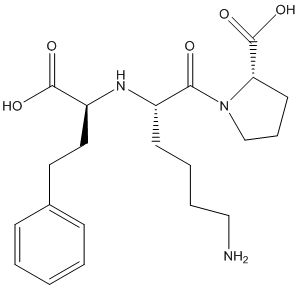
Here, O can have maximum of 2 lone pairs of electrons, N can have 1 lone pair of electrons and there is no lone pair of electrons on C and H atoms.
The valence electrons of C, H, N and O is 4, 1, 5 and 6 respectively.
The complete Lewis structure will be as follows:
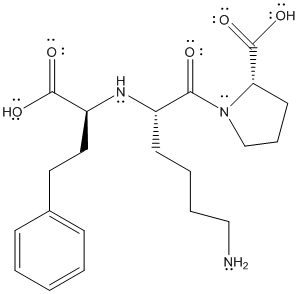
(b)
Interpretation:All the bond angles in lisinopril needs to be identified using the valence shell electron-pair repulsion model.
Concept Introduction: Hybridization is defined as mixing of orbital. The geometry of a central atom depends on its hybridization. The shape will be different from geometry if there are lone pair of electrons present on the central atom. The bond angles of central atom can be determined from its hybridization and geometry.
(b)
Explanation of Solution
The complete Lewis structure of lisinopril is as follows:
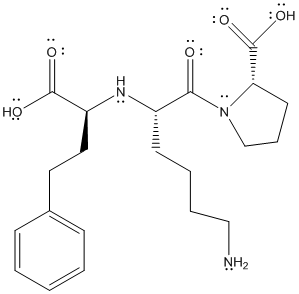
The valence electrons of C, H, N and O atom is 4, 1, 5 and 6 respectively. The C atom with 4 single bonds will have
The central atom with
(c)
Interpretation: The most polar bond in lisinopril needs to be determined.
Concept Introduction: A bond is said to be polar if there is electronegativity difference between the atoms. The most polar bond will be the one with maximum electronegativity difference between the bonded atoms.
(c)
Explanation of Solution
The structure is given as follows:
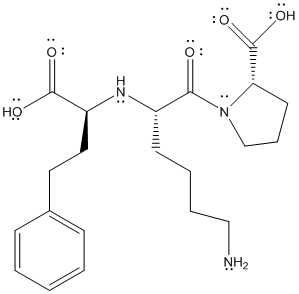
Here, C and H have comparable electronegativity thus, C-H bond is non-polar. The difference in electronegativity can be observed if C or H are bonded with O and N atoms.
Here, H is more electropositive than C thus, the electronegativity difference will be more in case of O-H or N-H bond as compared to O-C or N-C bonds.
Comparing O-H and N-H bond, O atom is more electronegative thus, electronegativity difference will be more in O-H and it is most polar bond in lisinopril.
(d)
Interpretation: Whether the given molecule is polar or non-polar needs to be determined.
Concept Introduction: If there are polar bonds present in a molecule then it is considered as a polar molecule.
(d)
Explanation of Solution
Due to the presence of polar O-H, N-H, C-O and C-N bonds, lisinopril is considered as a polar molecule.
(e)
Interpretation: This is to be explained whether lisinopril possess resonance or not.
Concept Introduction: Resonance is possessed by a molecule if there is possibility of delocalization of electrons. This can be positive if there is intercation between alternate lone pairs and pi bonds present in a molecule.
(e)
Explanation of Solution
The complete structure of lisinopril is as follows:
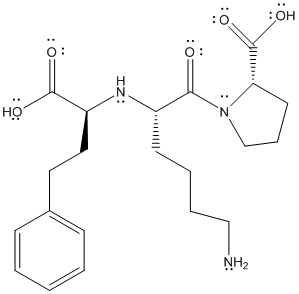
The above structure shows resonance as lone pair of electrons on oxygen atom is in conjugation with double bond. Similarly, lone pair of electrons on N atom is in conjugation with double bonded oxygen atom.
This is represented as follows:
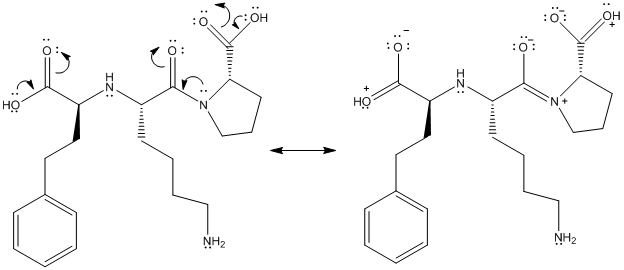
(f)
Interpretation: The
Concept Introduction: The functional groups are identity groups of the molecules. Functional groups define the types of
(f)
Explanation of Solution
The complete structure of lisinopril is as follows:

Here, -COOH, NH-, -NH2, CON- and benzene or
Functional groups are labelled as follows:
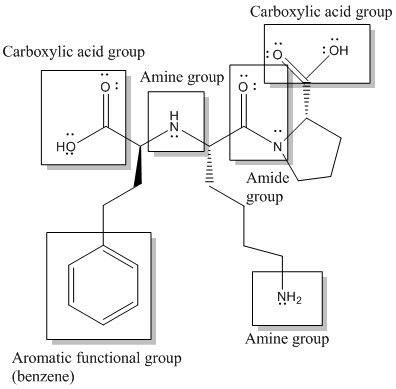
(g)
Interpretation: The molecular formula of lisinopril needs to be determined.
Concept Introduction: Molecular formula of any compound can be determined by calculating the total number of atoms of each element present in it.
(g)
Explanation of Solution
The complete structure of lisinopril is as follows:

There are 4 types of atoms present in the above molecule namely carbon atom, oxygen atom, hydrogen atom and nitrogen atom.
From the above structure, the molecular formula will be
(h)
Interpretation: The types of intermolecular forces present in the lisinopril molecules needs to be determined.
Concept Introduction: Intermolecular forces are defined as type of forces present between the two molecules when they come in contact of each other. The type of forces depends on the physical and chemical properties of atoms present in the molecule.
(h)
Explanation of Solution
The complete structure is represented as follows:
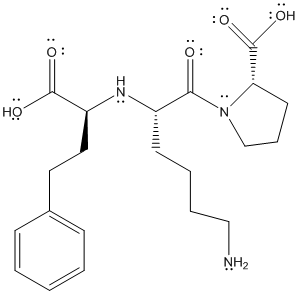
All the type of molecules containing non-polar bonds exhibits London dispersion forces. Due to the non-polar bonds (C-C and C-H) in the molecule. London dispersion forces are present.
Due to the presence of O-H bond, it also exhibits hydrogen bonding.
Want to see more full solutions like this?
Chapter 11 Solutions
Introduction to General, Organic and Biochemistry
- Complete the mechanismarrow_forwardComplete the mechanismarrow_forward8 00 6 = 10 10 Decide whether each of the molecules in the table below is stable, in the exact form in which it is drawn, at pH = 11. If you decide at least one molecule is not stable, then redraw one of the unstable molecules in its stable form below the table. (If more than unstable, you can pick any of them to redraw.) Check OH stable HO stable Ounstable unstable O OH stable unstable OH 80 F6 F5 stable Ounstable X Save For Later Sub 2025 McGraw Hill LLC. All Rights Reserved. Terms of Use | Privacy C ཀྭ་ A F7 매 F8 F9 4 F10arrow_forward
- Just try completing it and it should be straightforward according to the professor and TAs.arrow_forwardThe grading is not on correctness, so if you can just get to the correct answers without perfectionism that would be great. They care about the steps and reasoning and that you did something. I asked for an extension, but was denied the extension.arrow_forwardShow your work and do something that is reasonable. It does not have to be 100% correct. Just show something that looks good or pretty good as acceptable answers. Something that looks reasonable or correct would be sufficient. If you can get many of them correct that would be great!arrow_forward
- Show your work and do something that is reasonable. It does not have to be 100% correct. Just show something that looks good or pretty good as acceptable answers. Something that looks reasonable or correct would be sufficient. If you can get many of them correct that would be great!arrow_forwardTake a look at the following molecule, and then answer the questions in the table below it. (You can click the other tab to see the molecule without the colored regions.) with colored region plain 0= CH2-0-C-(CH2)16-CH3 =0 CH-O-C (CH2)7-CH=CH-(CH2)5-CH3 D CH3 | + OMPLO CH3-N-CH2-CH2-0-P-O-CH2 B CH3 A Try again * 000 Ar 8 0 ?arrow_forwardShow your work and do something that is reasonable. It does not have to be 100% correct. Just show something that looks good or pretty good as acceptable answers.arrow_forward
- Show your work and do something that is reasonable. It does not have to be 100% correct. Just show something that looks good or pretty good as acceptable answers.arrow_forward= 1 = 2 3 4 5 6 ✓ 7 8 ✓ 9 =10 Devise a synthesis to prepare the product from the given starting material. Complete the following reaction scheme. Part 1 of 3 -Br Draw the structure for compound A. Check Step 1 Step 2 A Click and drag to start drawing a structure. × ↓m + OH Save For Later S 2025 McGraw Hill LLC. All Rights Reserved. Terms of Use | Privaarrow_forwardPredict the products of this organic reduction: 田 Check AP + + H2 Lindlar catalyst Click an drawing 2025 McGraw Hill LLC. All Rigarrow_forward
 Chemistry: Principles and PracticeChemistryISBN:9780534420123Author:Daniel L. Reger, Scott R. Goode, David W. Ball, Edward MercerPublisher:Cengage Learning
Chemistry: Principles and PracticeChemistryISBN:9780534420123Author:Daniel L. Reger, Scott R. Goode, David W. Ball, Edward MercerPublisher:Cengage Learning
